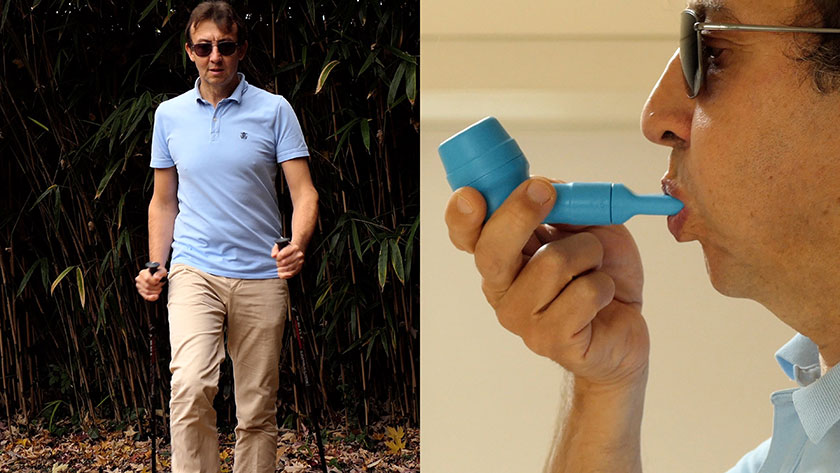To begin the session of bronchial clearance, you always start by drinking two sips of water to limit the phenomena of throat irritation, sometimes happening during the phase of expectorations.
Then you will perform one or two inspiratory maneuvers which consist of a maximum inspiration, by inflating the belly well, followed by a sustained apnea by leaning forward, while keeping the legs together.
After five seconds, you open your mouth, which sometimes causes secretions to rise without expiratory effort.
Then you will move on to the bronchial drainage phase, by a technique using an oscillating positive expiratory pressure device which is called an oscillating PEP by abbreviation.
After each inspiration carried out by the mouth, you will blow nine times into the oscillating PEP device.
The first four times, you exhale just 2 to 3 seconds into the device, keeping it horizontal.
Then you will blow longer, four more times into the device in a horizontal position, until the ball stops moving while avoiding to trigger a cough.
The ninth time, you will inspire amply and you will blow deeply by bringing in the belly as much as you can.
To go even further, you will tilt the device slightly downwards.
Finally, you will just have to take a deep breath, tilting the body backwards, before leaning quickly forward, while triggering a directed cough, the purpose of which is to facilitate the expectoration.
To achieve this directed cough, you must be careful to close the glottis at the right time, to increase the pressure in a reasonable way, without causing irritation in the laryngeal area.
This phase requires training.
If choking or thoracic-abdominal pain are triggered by the last maneuvers, it will be necessary to exhale without pushing to far.
In these conditions, you should favor a softer technique for bronchial clearance, like scraping, to avoid to trigger a cough.
After each sequence of bronchial clearance, you should always look at the color of the secretions, because if they are translucent or white, it is often not necessary to continue.
However, if they have a colored yellow, green or brown appearance, il will surely be necessary to continue the session.
Each sequence that includes: drinking 2 sips of water, the inspiratory maneuver with apnea, the nine expirations in an oscillating PEP device followed by a directed cough or a scraping, will be classically repeated one to five times, depending on the sensation of a possible presence of congestion.
The choice of the schedule remains very individual, although it depends on the planning of your day as well as the right moments when the secretions are identified as more easily mobilized.
For very congested people, and in the case of a course of antibiotics, it will be necessary to achieve several sessions of bronchial drainage per day, with the aim of reducing as much as possible the infectious load in the bronchial lumen.
When the evacuated secretions will be no longer colored, the sessions can be stopped.
But it should not be forgotten that the specific technique we have just described represents only 50% of the treatment of bronchial congestion.
The other 50% are the result of regular weekly physical activity: a minimum of two and a half hours per week, the better being five hours per week.
And as there is no defined maximum, you are free to do more.
In conclusion:
It is essential to take care of bronchial congestion if the discharged secretions have a colored yellow, green or brown appearance, because their stagnation in the respiratory tract promotes inflammation which weakens the lung tissue.

